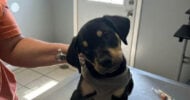Larry is a friend. We are not besties. He is a neighbor, a few miles down the road from our forty-eight-acre hobby farm in our quaint little town, surrounded by farmland, generational farmers, rusted old tractors, cornfields, livestock, and a few homes interspersed in between. He is a neighbor, nonetheless. And a friend.
I first met Larry when we were building our country home, where my wife dreamt of raising a family, akin to her own upbringing in the backwoods of West Virginia. Larry and his wife own a local fire and security company and were installing a system in our new home. That is when I first met him. We hit it off, right off the bat. Before long, we befriended each other.
Larry introduced me and my sons to RVing. He educated me on the art of towing a camper, building a campfire that could light up the night sky, and how to drain the septic tank of said camper without soiling our shirts, shorts, or hands. He introduced me to my first NHRA (National Hot Rod Association) race where my boys and I experienced thunderous roars, skull piercing screeching, and the pungent aroma of aerosolized tires as those top fuel dragsters raced down the quarter-mile track of Summit Motorsports Park in Norwalk, Ohio. Larry helped me coach our children’s youth soccer team (Team Zornboni) in the Zane Trace Youth Soccer League, and he helped me concoct a legendary play, the Zornboni Stampede, one Saturday morning, a play still revered by local soccer legends twenty years later.
Our mutual wives also became friends. They were and still are 4-H advisors to Ross County youth, Mama Hens and Mama Bears to those children. We four would occasionally go to dinner, visit our respective campsites at the county fair, and, most importantly, hoot and holler for our children as they competed in livestock shows, outhouse races, lip sync contests, and the county fair king and queen contests, much to their chagrin.
On December 9, 2020, Larry almost died.
Roughly two weeks after Thanksgiving, Larry presented to our hospital’s ER, panting, unable to breathe, fear and panic ravaging his mind, and a purple skin tone from head to toe. I was summoned to the ER to admit him, to treat him for COVID-19.
Over the course of my career, I have met and befriended countless respiratory therapists. I learned and benefited immensely from those RT friends.
Back in my training days, when I was a senior resident, when we were overconfident and “knew everything,” Jerry connected me to a mechanical ventilator: through SIMV mode, AC mode, pressure control mode, and CPAP mode. I was not intubated. He ventilated me via full face mask. He educated me, better yet schooled me, on what critically ill patients experience, suffer, and what terrorizes them as they lay awake, often restrained, under some level of sedation on a ventilator, as their minds wander aimlessly in a fight-or-flight response, wondering if they are going to live or die. I was humbled that day. I was schooled. I realized that I did not know everything, that I actually knew very little about mechanical ventilation. That epiphany I experienced, courtesy of Jerry RT, not my pulmonary attending physician.
During my neonatal intensive care unit training days, I learned how to secure the airway of a premature infant, a circumference smaller than your average straw. It was my respiratory therapist, standing beside me, instructing me, assisting me, ready to push me aside, if necessary, as I tried valiantly to save the life of my twenty-six-week-old premature infant.
As an attending physician, I worked with and befriended many respiratory therapists at our local hometown hospital. Often, it was during those heated moments that I was a team leader in a Code Blue, when a patient was effectively dead, when their survival depended upon my immediate actions and decisions. In states of panic, I called out for compressions, for medications, for timekeeper updates. And I called out for control of the patient’s airway. In those frenzied moments, it was then that calmness finally set in, when I could focus on the art of restarting/jumpstarting the patient’s circulation. I realized then that my respiratory therapist coolly and calmly controlled the airway and breathing of said patient so I could focus on the circulation. My RTs controlled the A (airway) and B (breathing) while I controlled the C (circulation) of the ABCs of resuscitation. And, more often than not, when my patients survived cardiopulmonary resuscitation, it was because of my RTs’ efforts and seldom my own.
It was Chuck, Jim, and Mark who did not panic, who did not freak out, who controlled the airway, secured it, who ventilated the patient, who allowed me to focus on saving the life before me. They guided me, assisted me, and, politely, corrected me when I commanded certain ventilator settings and modes.
There were times when my confidence superseded my abilities, when I could not secure an airway, whether a premature infant, an adult in distress, or the critical airway of a nurse friend and colleague. It was during those moments that Jenny (my Yarnell) respectfully, yet lovingly, pushed me aside, took control, and in the blink of an eye, established an airway and ventilated my patient, while I stared in wonder at her capabilities and techniques. And there was her sidekick, Kasie, who often complimented Jenny’s intubation skills, her knowledge of mechanical ventilation, and her ability to save me, the doctor, and, especially, my patient.
Over the years, I learned about different airway techniques, different tools at my disposal, different ventilator modes, and the art which my RT friends practice. I learned from Holly and her cool demeanor, from Amanda and the confidence she exuded, even when she had none, and how that confidence helped us in our resuscitation efforts. I learned from Tabi and her keen sense of impending doom when no one else could see or feel it coming. And I learned from Tawney, a shy, quiet, yet confident young lady who can secure an airway more effectively and efficiently than me and my physician colleagues combined.
And I especially learned over the years that, in those tense moments when my patient’s life was at stake, when establishing the airway was tantamount to their survival, having my RT at the head of the bed always improved my patient’s chance of survival and exponentially increased my confidence in running the Code Blue.
When I first saw Larry in the ER, strapped to his BIPAP, his purplish hue slowly fading to an ashen gray, I stood there, my PAPR protecting me from the virus destroying his lungs. He studied my actions, my inactions, the look in my eyes, the fear in my heart, and the ache in my soul. Through a muffled voice, he inquired of me: “How bad is it, Zoran?”
As he struggled to breathe, gasping with every spoken word, his oxygen levels plummeting, all I could focus on was, “How do I tell his wife Angie? What do I tell his daughter, his son? Will he be another statistic? Will his name be on the next death certificate I sign in addition to the hundreds I already signed during the Pandemic?”
Larry was hospitalized for twenty days, spent Christmas with us in the hospital, and despite all odds, despite our countless recommendations, he avoided intubation and mechanical ventilation. He wore his BIPAP 24/7 as it molded to the bridge of his nose, the contours of his face and cheeks, removing it only for mere seconds as he gulped any and all fluid nutrition he could consume while his body shriveled like a prune. Countless times, my pulmonary friends, my adoptive brothers, counseled me, counseled him, counseled his wife over the phone, that he needed to be intubated, that he needed mechanical ventilation, that without such intervention, his chance of survival was nearly zero.
But as stubborn and bullheaded as Larry was, he commanded and demanded that he remain DNR (do not resuscitate) and DNI (do not intubate). When I argued with him and inquired about his “irrational decisions,” he replied, “I love Angie and my family so much, that I am making my own decisions. I do not want to burden Angie or the kids with deciding my fate, when or if that time comes.”
Throughout his three weeks of living through Hell, the delirium terrorizing his mind, his wife and family living in isolation, unable to visit, Larry fought hard. He fought like Hell. And he argued with us, against us physicians. He told us he was going to walk out of the hospital. And he told us he would do so without intubation.
On December 22, 2020, hospital day twelve, my friend-turned-brother, Nick, and I entered Larry’s room, in full PPE, and encountered Larry sitting in a chair, off BIPAP, on heated high flow nasal cannula oxygen, his skin tone purple, his oxygen saturation 62 percent, not compatible with life. But Larry was smiling, surrounded by two respiratory therapists (Denise and Courtney) who vowed and were determined Larry would defy all odds and avoid intubation. “Now, you two just back off! Give us a moment. We just transitioned Larry to a chair for the first time. We just now took him off BIPAP and placed him on the Neptune (the high flow nasal cannula device) just before you walked in. He needs a break. His mind needs a break. His face needs a break. And if he does not tolerate it, we will place him back on BIPAP. We are not leaving his side. We will be with him the whole time. And get those dirty thoughts of intubation out of your head!” Courtney exclaimed. “Yeah, what she said!” Larry, too, exclaimed. Nick and I stood in the corner, fearing he would decompensate, fearing we would have to emergently intubate. However, over the next twenty minutes, his oxygen saturations slowly climbed to 65 percent, 69 percent, 74 percent, 81 percent, and then peaked and hovered at 85 percent, as we stood idly by. “You two can leave now!” Denise exclaimed. “We got this!”
Larry survived that day. He survived that hospitalization. He was discharged on December 28, 2020, the same day I received my COVID vaccine.
Six months later, Larry was able to wean off his home oxygen and attend my son’s high school graduation party. Larry survived. Not because of me, my pulmonary friends. But because of Denise and Courtney. They worked on Larry. They worked with Larry. They supported him. They protected him from intubation, when we were just realizing that those who survived COVID-19 were those who avoided intubation, mechanical ventilation. They trusted their guts. They trusted their intuition. They saved Larry’s life.
My daughter-in-law, also a respiratory therapist, experienced the great misfortune of studying and training during the height of the COVID pandemic. She witnessed, firsthand, the death and devastation COVID triggered. She and I cried together. She and I spoke a language only we could understand. Not her husband. Not my wife. Not my family. Only she and I.
Throughout my career, I learned from, benefitted from, and witnessed miraculous care of my patients from countless respiratory therapists, many of whom often go unrecognized. October 19 to 25, 2025, is Respiratory Care Week. This year, during Respiratory Care Week, I personally thank and honor all respiratory therapists out there: those who helped me, my patients, who educated me, who assisted me, who pushed me aside when necessary, those who arrived, who stayed, who bore the brunt of COVID when they were hailed as heroes and then later zeroes. I thank you all from the bottom of my heart. For Larry. Because of Larry. Thank you. He is alive today, because of you.

Larry (blue) and me at my son’s graduation party, six months after surviving COVID-19.
Zoran Naumovski is a hospitalist.




















![Why mocking food allergies in movies is a life-threatening problem [PODCAST]](https://kevinmd.com/wp-content/uploads/Design-3-190x100.jpg)
![Why being your own financial planner is costing you millions [PODCAST]](https://kevinmd.com/wp-content/uploads/Design-1-190x100.jpg)
